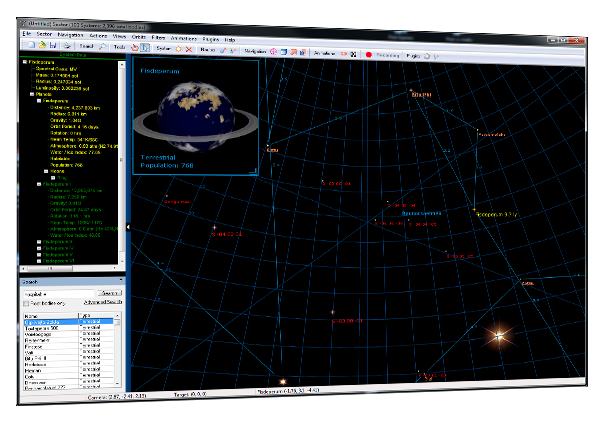

3D Star Mapping software for gamers, authors, and space buffs!
AstroSynthesis 3.0 - System System Generator Details
AstroSynthesis' built in Star System Generator isn't just a randomizer. When generating systems, the program applies many scientific principles from the areas of physics, planetary sciences, atmospheric chemistry, and astronomy. When you generate a sector map, you're not getting a mish-mash of unrelated planets and stars - you're getting plausible star systems!Generate Star Placements
The generator uses a sophisticated 3D algorithm to place stars. Stars will tend to cluster, so you'll see clouds of stars on your map (this is most visible on large maps). You can also select to use a more even distribution method of placing stars on your map.
Multiple Star Systems
Base star system types can be either single stars, or multiple star systems consisting of 2 or more stars. In addition, AstroSynthesis differentiates between near and far multiples. Far multiples can also be comprised of components that are themselves near multiples.
Individual Star Data
Once stars are on your map, details about each are generated. This includes their mass, radius, and luminosity. In addition, an appropriate Spectral Class is assigned based on temperature and luminosity (for example, our Sun's is G2V). On your map, your stars will be set to display in a color appropriate to their spectral class.
Other Stellar Bodies
In addition to standard Main Sequence stars, AstroSynthesis may place other types of bodies on your maps. Such things as white dwarfs, red giants, blue super giants, neutron stars, free planets, and black holes are all possible!
Planet Placements
Planets and other types of bodies, such as asteroid belts and space stations, are automatically placed around a star. Planets around near multiple star systems are adjusted or removed based on the stars' distances from each other. Other factors are also taken into consideration. Planets around Blue Giant stars are rare, for example (such stars are too young). Once planets are placed, their orbital distances and orbital periods (years) are calculated. A planet's rotation (day) is also calculated. If it's close enough to a star, it may be tide locked, and without rotation.
Planet Systems
Occasionally two similarly sized planets will orbit each other (while they both orbit a parent star). This is called a planet system. AstroSynthesis will occasionally generate these types of planet systems. It's even possible to see 3 planet systems - but that's very rare!
Planet Properties
Once it has your planets in place, AstroSynthesis will then generate detailed information about them. For example, it will generate a planet's radius and density. From there, such things as surface gravity are derived. These properties are then used in Atmospheric and Satellite generation.
Atmospheres
Atmospheres are complex things. If a planet is too small or too close to a star, it won't hold much of an atmosphere. If it's far out in a system, it might accumulate massive amounts of hydrogen. AstroSynthesis will calculate atmospheres suitable for a planet's size, orbital distance, and temperature. In addition, from this, any free standing surface water will also be noted.
Moons
If any moons are present around a planet, they can range in size from just small bodies in orbit (< 10 km) to large planet-like bodies with their own atmospheres. In fact, if you get a gas giant at the right position in a solar system, you very may well see one or more human friendly moons orbiting it!
Rings
Debris fields orbiting planets are more common then once believed, with all the gas giants in our own solar system having them. AstroSynthesis may place rings around both terrestrial planets and gas giants. In fact, it will also look at any low density moons in orbit, and calculate whether or not a moon is likely to be broken up by the parent planet's gravity and turned into a ring!
Planet Surface Maps
While not part of the initial map generation, AstroSynthesis can also generate spherically correct surface elevation maps of terrestrial planets. These maps can then be edited within Fractal World Explorer (included with AstroSynthesis), and even exported as contours for use within Fractal Mapper! In addition, great preview images of any gas giant planet can also be generated. These gas giant previews feature several colored layers of atmospheres blending together.
